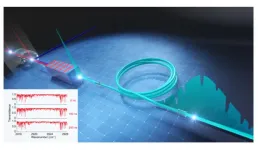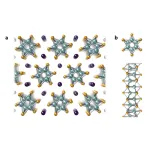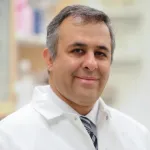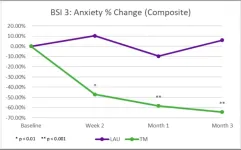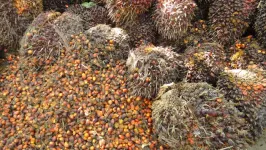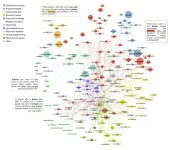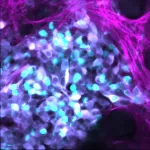(Press-News.org) Over the past decade, human papillomavirus (HPV) has increasingly been identified as a significant cause of certain head and neck cancers – for example, evidence suggests it causes 70% of oropharyngeal cancers in the United States.
Further, over the past three decades, incidence of HPV-driven cancers has increased substantially worldwide and in the U.S. While there are well-established screening tools, as well as vaccines, for HPV-driven cancers such as cervical cancer, there are fewer resources for HPV-driven head and neck cancers. As a result, researchers are working with a sense of urgency to develop innovative therapeutics to treat them.
One groundbreaking therapeutic has shown significant promise in a phase 1 clinical trial led by Antonio Jimeno, MD, PhD, co-leader of the University of Colorado Cancer Center Developmental Therapeutics Program and the CU Cancer Center head and neck cancer SPORE grant. Research results published today show that a microfluidic squeezing technology used on peripheral blood mononuclear cells (PBMCs), a type of immune cell, helps stimulate anti-tumor activity in a subtype of HPV16-positive cancers, including head and neck, cervical, and anal cancers.
“This technology is quite novel,” Jimeno explains. “As opposed to other cell therapies that require a patient’s cells to be genetically modified, this involves a different way of manipulating cells that does not lead to genetic modifications. It makes the process faster and perhaps more agile as to what you can direct the cells against.”
“Sending them to boot camp”
This research was motivated, in part, by an awareness that people diagnosed with certain HPV-driven head and neck cancers don’t have a lot of conventional treatment options. “We’re very aware of this situation, so we have a large group of investigators conducting immunotherapy and cell therapy clinical trials so that hopefully soon we will be able to offer patients more effective and less toxic options,” Jimeno says.
The phase 1 clinical trial focused on patients with a subtype of HPV16-positive solid tumors. Participants sat for a process called apheresis, which involves removing whole blood and putting it through a centrifuge to separate the whole blood into its individual parts. The aim of the apheresis session is to acquire between 5 to 10 billion PBMCs.
The PBMCs were then sent to a laboratory to be trained to find and kill cancer cells caused by HPV, “basically sending them to boot camp so they learn how to find and attack the cancer,” Jimeno says.
Using Cell Squeeze technology, the PBMCs were sent through very tight channels that opened pores on their surface. Then, the cells were fed a peptide, or piece of protein, related to the HPV virus – one that immune cells usually recognize – so that they could learn to recognize it and build a memory of it. The aim of the process is to help ensure that the next time these cells encounter HPV-driven cancer cells, they attack.
Once the cells had gone through the Cell Squeeze process, they were infused back into patients during a one-hour outpatient therapy session. This process happened every 21 days and did not require patients to receive concurrent immunosuppression or chemotherapy.
Showing promising results
“It’s very early in the process with this technology, but the results we observed in this phase 1 trial are promising,” Jimeno says. “The fact that the cells are from a patient’s own blood means that rejection is not going to be an issue. Also, the fact that they have not been genetically modified on their surfaces makes them less likely to attract unwanted attention from the immune system.”
While some study participants experienced mild side effects such as fatigue, rash, or a slight immune reaction, “the toxicity was perceived to be manageable and significantly outweighed by the benefits,” Jimeno says. “We did biopsies before and after therapy, and after the therapy we could see these modified cells we had given back to the patient, and they were activated and sort of 'chewing' at cancer cells.
“Most importantly, we had some patients here in Colorado who were on the therapy for almost a year and their disease remained stable. For cancer patients who have run out of other options, being able to be on a therapy without very serious side effects, that doesn’t require a hospital stay or supplementary chemotherapy, is a very appealing option.”
Following the phase 1 trial, a phase 1B trial is ongoing that combines first-generation cells and immunotherapies. Another study recently opened that works with a second generation of the PBMCs made in an improved way, Jimeno says. Further, inclusion criteria for the study with second-generation PBMCs are much broader.
Because the process does not require genetic modifications, Jimeno says, it is fast and agile, and has potential for other types of cancer.
“The promise of these cell technologies is that many of them are being developed in a way that they can be actually generated at the point of delivery,” Jimeno explains. “We can envision a future where these or similar approaches work, and where we have small processors locally – for example, at the Gates Biomanufacturing Facility here on campus – so that we’re reducing patient wait times. We could potentially offer a therapy that could be turned around very soon after we collect a patient’s cells. This is a super exciting field and that’s why we’re so interested and working hard to drive this.”
END
Innovative technology shows great promise against certain head and neck cancers
Antonio Jimeno, MD, PhD, led research studying a cell squeezing process used to treat a subtype of HPV16-driven head and neck cancer
2023-03-04
ELSE PRESS RELEASES FROM THIS DATE:
Study shows those infected with COVID in the first wave in 2020 were 40% less likely than those who were not to get COVID-19 during the first six months of Omicron activity
2023-03-04
**Note: the release below is a special early release from the European Congress of Clinical Microbiology & Infectious Diseases (ECCMID 2023, Copenhagen, 15-18 April). Please credit the conference if you use this story**
Compared to adults who did not have COVID in the first wave (March to September 2020), adults infected with COVID-19 in that first wave were 40% less likely to become infected during the first six months of Omicron activity (December 2021 to May 2022), concludes a new Canadian study to be presented at this year’s European Congress of Clinical Microbiology & Infectious Diseases (ECCMID) in Copenhagen, Denmark (15-18 April). The study was led ...
Detecting the molecular vibration information faster and better by “stretching” time
2023-03-04
Infrared spectroscopy is a non-invasive tool to identify unknown samples and known chemical substances. It is based on how different molecules interact with infrared light. You may have seen this tool at airports, where they screen for illicit drugs. The technique has many applications: liquid biopsy, environmental gas monitoring, contaminant detection, forensic analyses, exoplanet search, etc. But the traditional infrared spectroscopy methods provide low (temporal) resolution data. They are usually only applied for static samples because spectral data acquisition is a slow process. Detecting fast-changing phenomena ...
Scientists thread rows of metal atoms into nanofiber bundles
2023-03-04
Tokyo, Japan – Researchers from Tokyo Metropolitan University have successfully threaded atoms of indium metal in between individual fibers in bundles of transition metal chalcogenide nanofibers. By steeping the bundles in indium gas, rows of atoms were able to make their way in between the fibers to create a unique nanostructure via intercalation. Through simulations and resistivity measurements, individual bundles were shown to have metallic properties, paving the way for application as flexible nanowires in nanocircuitry.
Atomic wires of transition metal chalcogenides (TMCs) ...
Intellifoods Labs, LLC strengthens partnership with Mason scientists to reduce food bacterial contamination detection time
2023-03-03
Mason Associate Professor of Infectious Diseases and Microbiology, Ramin M. Hakami has received a total of $35,000 in grants from Intellifoods Labs, LLC to continue examining methods to reduce the time to detect the presence of bacteria in food samples.
Numbers and types of foodborne disease occurrences have increased over time and are a major global public health concern. Hakami and his team seek to reduce the time to identify both live and dead bacteria in food samples using fluorescence detection. The team aims to optimize the detection ...
Transcendental Meditation highly effective in rapidly reducing healthcare worker burnout symptoms during the height of the Covid crisis
2023-03-03
Healthcare providers (HCP) at three Miami hospitals during the height of the Covid crisis, who practiced the Transcendental Meditation technique (TM), showed a rapid and highly significant reduction in stress-related burnout symptoms such as somatization, depression, anxiety, sleep disturbances, and emotional exhaustion, as well as significant improvement in mental well-being, compared to a parallel matched lifestyle-as-usual group (LAU), according to a new study published today in PLOS ONE.
A total of 65 healthcare providers at the three Miami hospitals (Baptist, ...
Unique hybrid reefs deployed off Miami Beach
2023-03-03
The first piece of a series of concrete structures was lowered into the water off the coast of Miami Beach on Wednesday morning, a massive crane on the deck of a floating barge hoisting the unit into the air and sinking it to the seabed.
During the next six hours, crewmembers aboard the barge would repeat that process until the structures, some stacked on top of each other, were settled on the seafloor, 14 feet below the surface.
To casual observers onshore, the daylong operation might have seemed routine. But this maritime activity was hardly run-of-the-mill.
In ...
Scientist to launch interstellar space music
2023-03-03
A scientist from Anglia Ruskin University (ARU) will premiere a new piece of music at the SXSW EDU festival that has been created using data beamed back to Earth from interstellar space.
On Thursday, 9 March, Dr Domenico Vicinanza will be joined on stage in Austin, Texas, by Dr Alyssa Schwartz, Visiting Assistant Professor of Flute and Musicology at Fairmont State University, to perform music shaped by scientific readings collected by NASA’s Voyager 1 spacecraft.
Dr Vicinanza, a Senior Lecturer in ARU’s School of Computing and Information Science, is a leading expert ...
Mechanical weeding promotes ecosystem functions and profit in industrial oil palm
2023-03-03
Oil palm trees are the most productive oil crop and global demand is increasing. However, their productivity is due to conventional management practices including high fertilizer usage and herbicide application, resulting in severe environmental damage. A new study by an international, multidisciplinary research team led by the University of Göttingen, shows that shifting to mechanical weeding and reducing fertilizer usage lead to significant increases in both ecosystem multifunctionality and profit. The scientists compared different environmental measures and economic indicators in mechanical weeding, herbicide application, and combinations of these with high and reduced fertilizer ...
News you can use—to better predict food crisis outbreaks
2023-03-03
A team of researchers has developed a machine learning model that draws from the contents of news articles to effectively predict locations that face risks of food insecurity. The model, which could be used to help prioritize the allocation of emergency food assistance across vulnerable regions, marks an improvement over existing measurements.
“Our approach could drastically improve the prediction of food crisis outbreaks up to 12 months ahead of time using both real-time news streams and a predictive model that is simple to interpret,” says Samuel Fraiberger, a visiting researcher at ...
Tumour cells’ response to chemotherapy is driven by randomness
2023-03-03
Cancer cells have an innate randomness in their ability to respond to chemotherapy, which is another tool in their arsenal of resisting treatment, new research led by the Garvan Institute of Medical Research shows.
Understanding why some tumour cells become resistant to chemotherapy is a core challenge in cancer research, as chemotherapy is still a frontline treatment for most cancers.
The new research shows that tumour cells from neuroblastoma – cancer that develops in the body’s ‘fight or flight’ sympathetic nervous system – can move between states of responding, or not, to chemotherapy.
“We showed there is ‘noise’ in the process of cell ...
LAST 30 PRESS RELEASES:
University of Oklahoma researcher awarded funding to pursue AI-powered material design
Exploring how the visual system recovers following injury
Support for parents with infants at pediatric check-ups leads to better reading and math skills in elementary school
Kids’ behavioral health is a growing share of family health costs
Day & night: Cancer disrupts the brain’s natural rhythm
COVID-19 vaccination significantly reduces risk to pregnant women and baby
The role of vaccination in maternal and perinatal outcomes associated with COVID-19 in pregnancy
Mayo Clinic smartwatch system helps parents shorten and defuse children's severe tantrums early
Behavioral health spending spikes to 40% of all children’s health expenditures, nearly doubling in a decade
Digital cognitive behavioral treatment for generalized anxiety disorder
Expenditures for pediatric behavioral health care over time and estimated family financial burden
Air conditioning in nursing homes and mortality during extreme heat
The Alps to lose a record number of glaciers in the next decade
What makes a good proton conductor?
New science reporting guide published for journalists in Bulgaria
New international study reveals major survival gaps among children with cancer
New science reporting guide published for journalists in Turkey
Scientists develop a smarter mRNA therapy that knows which cells to target
Neuroanatomy-informed brain–machine hybrid intelligence for robust acoustic target detection
Eight SwRI hydrogen projects funded by ENERGYWERX
The Lundquist Institute and its start-up company Vitalex Biosciences Announces Strategic Advancement of Second-Generation fungal Vaccine VXV-01 through Phase 1 Trials under $40 Million Competitive Con
Fine particles in pollution are associated with early signs of autoimmune disease
Review article | Towards a Global Ground-Based Earth Observatory (GGBEO): Leveraging existing systems and networks
Penn and UMich create world’s smallest programmable, autonomous robots
Cleveland researchers launch first major study to address ‘hidden performance killer’ in athletes
To connect across politics, try saying what you oppose
Modulating key interaction prevents virus from entering cells
Project explores barriers to NHS career progression facing international medical graduates
Jeonbuk National University researchers explore the impact of different seasonings on the flavor perception of Doenjang soup
Two Keck Medicine of USC Hospitals named Leapfrog Top Teaching Hospitals
[Press-News.org] Innovative technology shows great promise against certain head and neck cancersAntonio Jimeno, MD, PhD, led research studying a cell squeezing process used to treat a subtype of HPV16-driven head and neck cancer
